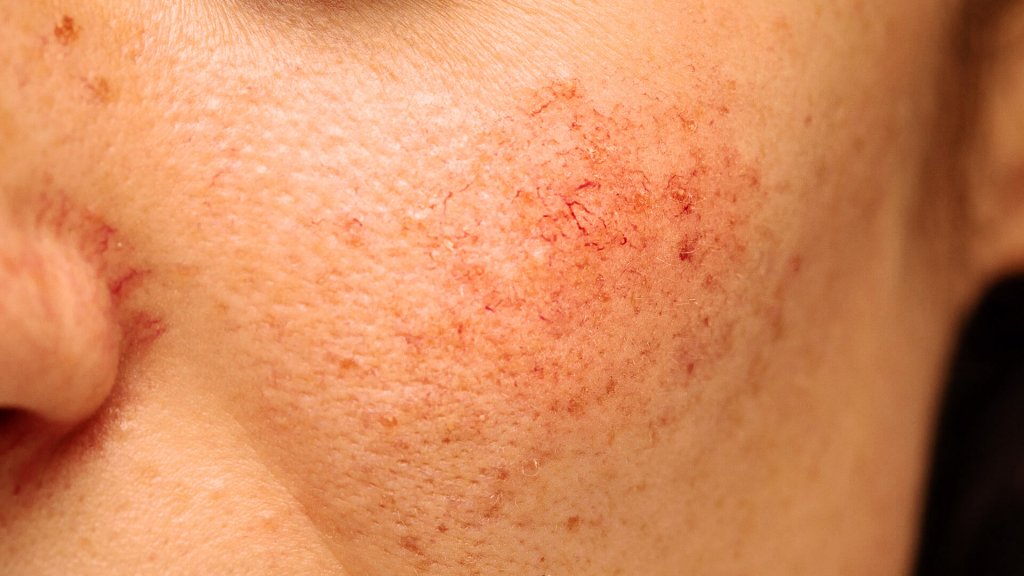Reduziere Rosacea
mit Sanubiom SkinCare Protect mit Phage Technology
- REDUZIERT Rötungen und Juckreiz
- FÖRDERT das Gleichgewicht der Haut
- STÄRKT die Hautschutzbarriere
Rosacea

A rosacea flare-up often comes unexpectedly and suddenly. Redness on the face, itching and pain can be the result.
If the skin becomes increasingly dry and prone to inflammation, the chronic inflammatory skin disease rosacea becomes life-limiting. Those affected usually feel uncomfortable in public and try to conceal the redness.
However, this causes further irritation of the facial skin.
In this article, you can find out how to recognize a rosacea flare-up and what you can do to avoid it.
An acute rosacea flare-up can be recognized by suddenly reddened facial skin. The cause is dilated blood vessels under the skin. This reaction is also known as a “flush”.
It is also possible that connective tissue and sebaceous glands enlarge, which can also lead to a thickening of the nose. The development of nodules, papules and pustules on the cheeks, nose, chin and forehead is also common.
mit Sanubiom SkinCare Protect mit Phage Technology
Probiotic
Skin protection
This can lead to pain and itching in the affected area. Patients often experience a reduction in their quality of life due to the symptoms.
Visible veins and skin growths lead to insecurity in public, which is why those affected often withdraw.
Rosacea is a chronic inflammatory disease of the skin, the exact cause of which is not yet known.
The redness on the face is usually caused by a specific trigger. However, if you know your personal triggers for a rosacea flare-up, you can avoid them.
If the skin disease is severe, it is referred to as rosacea fulminans. How long a rosacea flare-up lasts depends on the stage of the disease.
It often begins with recurring redness, which quickly disappears again and does not have to be a burden.
The reason for this is dilated blood vessels. At the beginning, they quickly contract again. If the disease remains untreated, the redness can persist for a long time. This is because the blood vessels “unlearn” to constrict.

As a result, the skin is permanently supplied with blood and it can take weeks for the redness to subside. In the final stage, severe eczema and inflammation of the skin occur. This is when the level of suffering is particularly high.
Therefore, it should be clarified right at the beginning of possible rosacea symptoms what they are. Although rosacea cannot be cured, it can be treated well with the right treatment.
There are various triggers that lead to a rosacea flare-up. This includes:
You may be interested in this blog post on the right diet for rosacea: Diet for rosacea – foods you should avoid!

Spicy foods in particular cause the veins under the skin to expand. But sugary and fatty foods also have an effect.
Environmental stimuli such as UV radiation and infrared radiation can also lead to an increase in symptoms.
Certain ingredients in cosmetics, detergents and shower gels often contain chemicals that are not suitable for sensitive skin. Care should therefore be taken to ensure that the composition is as natural as possible.
Certain home remedies can help with an acute rosacea flare-up. Compresses made from green or black tea support the skin with anti-inflammatory ingredients.
Fresh aloe vera gel has a cooling effect and relieves itching and pain. Rosacea flare-ups can be avoided by avoiding known triggers. If you are going to be in the sun for a long time, for example, sun protection is important for your skin.
If you suspect that you are particularly susceptible to certain foods, you can avoid them for a while.
If the flare-ups do not occur, you should avoid them permanently. Keeping a food diary can help here.
We at Sanubiom have developed Phage Technology facial care to reduce the symptoms. The use of phages reduces bad bacteria, which can also promote rosacea.
Bacteriophages are viruses that feed on Staphylococcus aureus bacteria. These bacteria are often responsible for inflammation and dryness of the skin.
The bacteriophages cause these harmful bacteria to burst and the balance of the skin is restored.